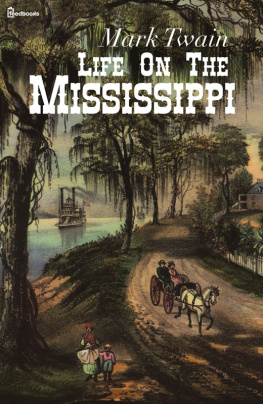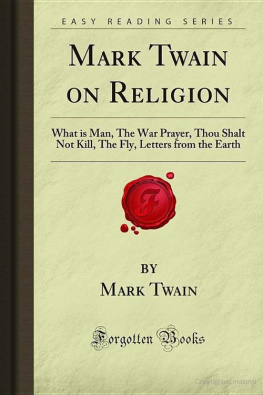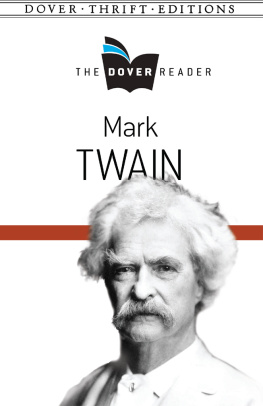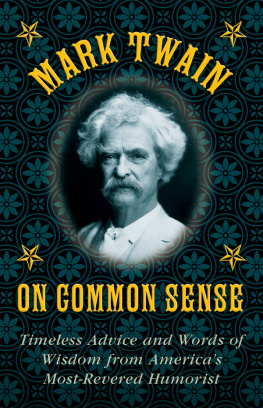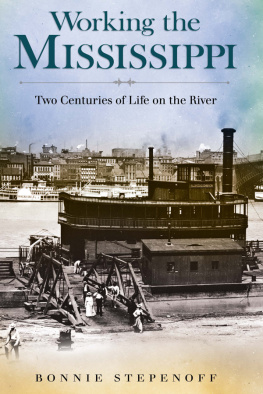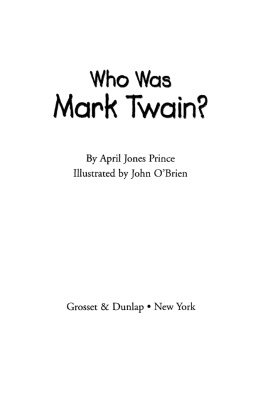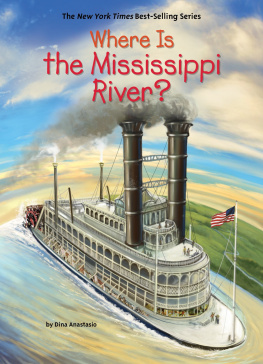About Twain:Samuel Langhorne Clemens (November 30, 1835 April 21, 1910),better known by the pen name Mark Twain, was an American humorist,satirist, writer, and lecturer. Twain is most noted for his novelsAdventures of Huckleberry Finn, which has since been called theGreat American Novel, and The Adventures of Tom Sawyer. He is alsoknown for his quotations. During his lifetime, Clemens became afriend to presidents, artists, leading industrialists, and Europeanroyalty. Clemens enjoyed immense public popularity, and his keenwit and incisive satire earned him praise from both critics andpeers. American author William Faulkner called Twain "the father ofAmerican literature." Source: Wikipedia
Also available on FeedbooksTwain:- TheAdventures of Huckleberry Finn (1885)
- TheAdventures of Tom Sawyer (1876)
- RoughingIt (1872)
- AConnecticut Yankee in King Arthur's Court (1889)
- The$30,000 Bequest and other short stories (2004)
- PersonalRecollections of Joan of Arc (1896)
- TomSawyer, Detective (1896)
- TheWar Prayer (1916)
- TomSawyer Abroad (1894)
- TheJumping Frog (1865)
Note: This book is brought toyou by Feedbooks
http://www.feedbooks.com
Strictly for personal use, do not use this file for commercialpurposes.
The "Body of the Nation"
But the basin of the Mississippi is the bodyofthenation. All the other partsare but members, important in themselves, yet more important intheir relations to this. Exclusive of the Lake basin and of300,000 square miles in Texas and New Mexico, which in many aspectsform a part of it, this basin contains about 1,250,000 squaremiles. In extent it is the second great valley of the world,being exceeded only by that of the Amazon. The valley of thefrozen Obi approaches it in extent; that of La Plata comes next inspace, and probably in habitable capacity, having abouteight-ninths of its area; then comes that of the Yenisei, withabout seven-ninths; the Lena, Amoor, Hoang-ho, Yang-tse-kiang, andNile, five-ninths; the Ganges, less than one-half; the Indus, lessthan one-third; the Euphrates, one-fifth; the Rhine,one-fifteenth. It exceeds in extent the whole of Europe,exclusive of Russia, Norway, and Sweden. ItwouldcontainAustriafourtimes, GermanyorSpainfivetimes, Francesixtimes, theBritishislandsorItalytentimes. Conceptions formed from the river-basins of Western Europe arerudely shocked when we consider the extent of the valley of theMississippi; nor are those formed from the sterile basins of thegreat rivers of Siberia, the lofty plateaus of Central Asia, or themighty sweep of the swampy Amazon more adequate. Latitude,elevation, and rainfall all combine to render every part of theMississippi Valley capable of supporting a dense population. As A dwelling-placeforcivilizedmanitisbyfarthefirstuponourglobe.
Editor's Table, Harper's Magazine, February1863
Chapter The River And Its History
The Mississippi is well worth reading about. Itis not a commonplace river, but on the contrary is in all waysremarkable. Considering the Missouri its main branch, it isthe longest river in the worldfour thousand three hundredmiles. It seems safe to say that it is also the crookedestriver in the world, since in one part of its journey it uses up onethousand three hundred miles to cover the same ground that the crowwould fly over in six hundred and seventy-five. It dischargesthree times as much water as the St. Lawrence, twenty-five times asmuch as the Rhine, and three hundred and thirty-eight times as muchas the Thames. No other river has so vast adrainage-basin: it draws its water supply from twenty-eightStates and Territories; from Delaware, on the Atlantic seaboard,and from all the country between that and Idaho on the Pacificslopea spread of forty-five degrees of longitude. TheMississippi receives and carries to the Gulf water from fifty-foursubordinate rivers that are navigable by steamboats, and from somehundreds that are navigable by flats and keels. The area ofits drainage-basin is as great as the combined areas of England,Wales, Scotland, Ireland, France, Spain, Portugal, Germany,Austria, Italy, and Turkey; and almost all this wide region isfertile; the Mississippi valley, proper, is exceptionally so.
It is a remarkable river in this: that instead of wideningtoward its mouth, it grows narrower; grows narrower anddeeper. From the junction of the Ohio to a point half waydown to the sea, the width averages a mile in high water: thence to the sea the width steadily diminishes, until, at thePasses, above the mouth, it is but little over half a mile. At the junction of the Ohio the Mississippis depth is eighty-sevenfeet; the depth increases gradually, reaching one hundred andtwenty-nine just above the mouth.
The difference in rise and fall is also remarkablenot in theupper, but in the lower river. The rise is tolerably uniformdown to Natchez (three hundred and sixty miles above themouth)about fifty feet. But at Bayou La Fourche the riverrises only twenty-four feet; at New Orleans only fifteen, and justabove the mouth only two and one half.
An article in the New Orleans Times-Democrat, based uponreports of able engineers, states that the river annually emptiesfour hundred and six million tons of mud into the Gulf ofMexicowhich brings to mind Captain Marryats rude name for theMississippithe Great Sewer. This mud, solidified, wouldmake a mass a mile square and two hundred and forty-one feethigh.
The mud deposit gradually extends the landbut only gradually;it has extended it not quite a third of a mile in the two hundredyears which have elapsed since the river took its place inhistory. The belief of the scientific people is, that themouth used to be at Baton Rouge, where the hills cease, and thatthe two hundred miles of land between there and the Gulf was builtby the river. This gives us the age of that piece of country,without any trouble at allone hundred and twenty thousandyears. Yet it is much the youthfullest batch of country thatlies around there anywhere.
The Mississippi is remarkable in still another wayitsdisposition to make prodigious jumps by cutting through narrownecks of land, and thus straightening and shortening itself. More than once it has shortened itself thirty miles at a singlejump! These cut-offs have had curious effects: theyhave thrown several river towns out into the rural districts, andbuilt up sand bars and forests in front of them. The town ofDelta used to be three miles below Vicksburg: a recent cutoffhas radically changed the position, and Delta is now twomilesabove Vicksburg.
Both of these river towns have been retired to the country bythat cut-off. A cut-off plays havoc with boundary lines andjurisdictions: for instance, a man is living in the State ofMississippi to-day, a cut-off occurs to-night, and to-morrow theman finds himself and his land over on the other side of the river,within the boundaries and subject to the laws of the State ofLouisiana! Such a thing, happening in the upper river in theold times, could have transferred a slave from Missouri to Illinoisand made a free man of him.

